Comparing pollen substitutes based on amino acid profiles is essential for determining their effectiveness in meeting honey bee nutritional needs.
Here’s how you can make meaningful comparisons:
1. Total Free Amino Acid Content
Higher total amino acids indicate greater potential for bees to build proteins, but total isn’t enough—balance matters most. In one comparative study, diets with higher total free amino acids showed better nutritional performance, but specific EAAs (like isoleucine, leucine, lysine, and methionine) within those totals made the greatest difference.[1][2][3]
2. Essential Amino Acid Balance
Artificial pollen substitutes may have high protein but lack the proper EAA proportions. The best-performing diets are those with balanced EAAs (arginine, histidine, lysine, methionine, phenylalanine, leucine, isoleucine, threonine, valine, tryptophan):[4][5]
- Some popular commercial subs, like Mann Lake’s Ultra Bee, emphasize complete amino acid profiles to ensure bees can utilize the protein fully, not just have access to it.[6]
- Natural pollens often differ based on botanical source and season; even high-protein pollens may lack specific EAAs needed for optimal colony growth.[5][4]
3. Relative Ratios and Limiting Amino Acids
- The proportion of each EAA, especially in relation to leucine, determines how well bees can utilize the protein. Deficiency in any one EAA (isoleucine and valine are common limiting factors) can reduce brood rearing and colony performance—even if overall protein is adequate.[4][5]
- Randy Oliver’s comparative trials found that some pollen subs with lower crude protein outperformed others because their EAA ratios were closer to ideal for bee growth.[5]
Sample Comparison Points
| Pollen Sub/Diet | Total Free AA (mg/g) | Key Balanced EAAs | Noted Deficiency/Strength |
| Diet 3 (test sub)[3] | 18.69 | Lysine, Methionine, Glutamic | Highest total AAs, good EAA mix |
| Ultra Bee[6] | High (undisclosed) | Complete AA profile | Focuses on bioavailable protein |
| Control Diet[3] | 6.67 | Leucine, Phenylalanine | Lower overall, may lack balance |
4. Practical Tips
- Use Randy Oliver’s Amino Acid Calculator to visualize and compare EAA ratios of substitutes (download from Scientific Beekeeping).
- Prioritize substitutes whose EAA ratios match or exceed de Groot/Oliver recommendations across all EAAs—not just high protein percentages.
- If brewing your own diets, always test and adjust EAA profiles for season, local pollen sources, and bee needs.[3][4][5]
In summary:
The best pollen substitutes for bee feeding are those with balanced, complete essential amino acid profiles—not just high protein. Balanced EAAs support brood rearing, longevity, and strong colonies.[6][3][4][5]
⁂
- https://www.sciencedirect.com/science/article/abs/pii/S1226861522001005
- https://pmc.ncbi.nlm.nih.gov/articles/PMC10889207/
- https://pmc.ncbi.nlm.nih.gov/articles/PMC11122370/
- https://pmc.ncbi.nlm.nih.gov/articles/PMC11173770/
- https://scientificbeekeeping.com/a-comparative-trial-of-the-pollen-subs-part-4-why-did-some-subs-outperform-others/
- https://www.mannlakeltd.com/blog/pollen-substitutes-what-is-the-difference-between-ultra-bee-and-ultra-bee-plus/
- https://scientificbeekeeping.com/a-comparative-trial-of-the-pollen-subs-2020-part-1/
- https://scientificbeekeeping.com/a-comparative-trial-of-the-pollen-subs-part-6-do-we-need-to-revise-de-groot/
- https://scientificbeekeeping.com/observations-on-pollen-subs/
- https://scientificbeekeeping.com/pollen-supplement-formula/



